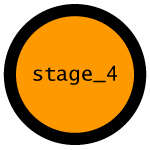

Creating a chassis from the latitudes designed in stage_1
- The first step taken to design the chassis was determining the distance
between the suspension's A-arms, which determines the width of the chassis.
The distance between the A-arms is a function of two things: spat size and
spat location relative to the edge of the car. The size of the spat is related
to the maximum turning angle of the front wheels, which is 27 degrees according
to the solar car steering team. The team rotated the wheels to 27 degrees
in either direction and noticed that the wheels interfered with the current
spats. The team redrew the spats to accommodate
the wheel in either configuration with a clearance of 12mm. The new spats
were then located 50mm from either edge of the car, as specified by Dr. Harrison.
Next, the A-arms were added to the drawing and the distance between them was
measured.
- Of course, the chassis must not protrude through, interfere with, or touch
the body of solar car. To prevent this, a 3D spatial constraint needed to
be constructed. To do this, a rectangle the width of the chassis was drawn
inside each latitude in AutoCAD. These rectangles
were then located in the 3D workspace of MDT. To further ensure that no interference
occurred between the chassis and body, these rectangles were offset
a distance of 50.8mm.
- Upon inspection of the current A-arm assemblies, it was determined that
the portions of the chassis to which the A-arms would be attached needed to
be horizontal. The 2D drawings of the spat/wheel/A-arm assembly were inserted
in MDT to determine the locations where of the horizontal sections. Once
the locations and lengths of the horizontal sections were determined, the
chassis was drawn.
- Originally, the driver's compartment was too narrow in the estimation of
the team, so it was widened to accommodate a driver more easily. The steel
tubing of the chassis stands is far less susceptible to failure when the tubing
completely in compression or tension. Cross bracing
was added to triangulate the compartments of the chassis. Triangulation
of chassis compartments serves to transform all forces and moments on the
chassis into compressive and tensile forces in
the cross bracing.
- To give the chassis a more realistic feel, the lines that represent the
vertical and horizontal components of the chassis were used as the trajectory
for a sweep. A sweep is created by sketching or selecting a trajectory and
then sketching a section to follow along it. Click
Here

